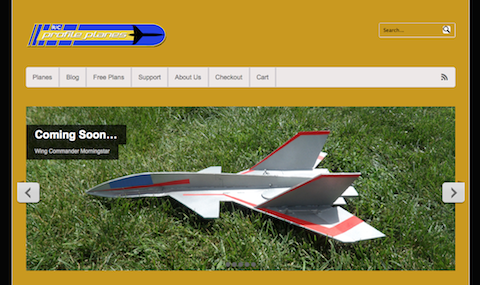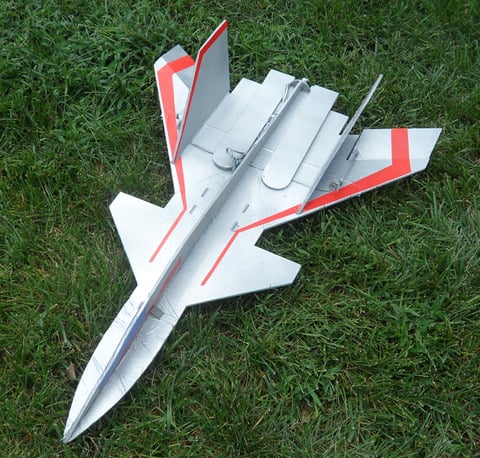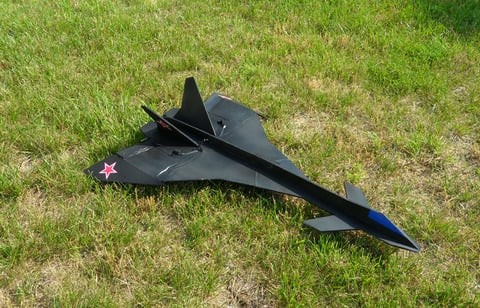It's been a while since we posted an interview with a designer or company here on Parkjets, so to kick off the new year, we thought you might like to hear from a designer that is running a business! It's like a two for one. We reached out to Chris Carpenter, designer of the MIG 31 "Firefox" and the F-95 "Morningstar," and he is the guy on the other end of the line when you contact RCProfilePlanes.com. He recently sent over the plans for the Morningstar and we asked him a few questions. So without boring introductions, let's get started with the interview!
Alright, first of all, thanks for taking some time to actually do this interview. We really appreciate it. Let's kick this thing off right and why don't you tell us about yourself. Where you live, work, how long you have been in the hobby, how long you have been designing, all that good stuff?
My name is Chris Carpenter. I live in Laurel MD and I work in Information Security for the Federal Government. I’ve been flying RC airplanes for about 13 years. I have been designing planes for about seven years. I remember staring at the Sear catalog as a kid (before they discontinued it….) and dreaming of having my own RC Plane. I’m blown away these days by how cheap and easy it is to get into the hobby. It’s a wonderful time to be a RC pilot.
You are right on that point, the cost to enter the hobby has never been lower. So far, it looks like you have about half a dozen designs out there, mostly focusing on modern jets, much like Parkjets. But we have to ask, do you have a favorite?
My favorite plane is the MIG-31 Firefox. It’s from the movie of the same name (Firefox). The movie is horrible except for the plane. I was in love with that jet from the moment I saw it. The Firefox I designed looks great in the air. The design is really clean and it’s pretty fast. I was also surprised how well it slows down and how easy to land it is. It just looks mean up in the air. The Firefox is also the most popular plane I sell as well. I think it’s the most popular for the same reasons. It flies great, looks really mean in the air and it also goes together very easy. I think there is a lot of sentimentality for this plane. It’s just a piece of 1980s nostalgia that I think a lot people can relate to. I remember flying it at Fun Fly at my local airfield and being asked, “What plane is that?” When I answered the announcer got on the mike and said, “Hey! Clint Eastwood wants his plane back!”. It was pretty funny.
You know, it's funny, that movie, well just about everyone has seen it. I'm not sure if it is just because Clint Eastwood was such a star back then or if it was the cold war backdrop to the plot. Who could forget the rear-firing missiles? I guess it's no surprise that it's the most popular kit on your website.
Shifting gears a little to the nuts and bolts of building, many modelers are using Depron foam, it's been the standard for years. Is that what you prefer to work with or do you use a different material?
I started out building with Bluecore foam and it’s my preferred medium. Depron is nicer and sands better but the higher cost just makes it impractical for me. I can’t find the original Bluecore locally anymore but I can get Dow Protection Board III which is very similar. For profile plane like I build it works out great. If you take the protective film off it still sands well. You can use Balspar paints from Lowes to paint it without melting as well.
Nothing wrong with Bluecore, but it is getting difficult to find these days, and when we find it, its usually damaged or cracked from poor handling. So we know what you like to use when you build, but what do you like to use, what modeling software do you prefer when you design?
I design all my planes in Sketchup for a couple of reasons. One, it was pretty easy to learn and two the PhlatScript plugin. PhlatBoyz created the PhlatScript plugin for Sketchup and it makes it simple to export Sketchup designs to G-Code for the CNC machine. There are probably better programs out there but the learning curve was for Sketchup was really short and so far it has met my needs.
I think most people use Google Sketchup for the exact reasons you state, it's a good-enough product that has a price tag of zero. Can't beat that. What about someone that wanted to design a plane for the first time, what is the number one thing they need to do first?
It really depends on the subject your modeling and what you want out of the model. For me the first thing is to find a good 3 view drawing of the plane. Google is your friend. A lot of times a simple search for the plane and “3 view” yields a great drawing. You can refine your search for large images and you are in business. After I find a good drawing or images I decide how much detail is realistic for the amount of effort I am willing to put in. I know some people are super scale detail enthusiasts but I go more for instant gratification. So, I usually look at the three view and figure out how it will look as a profile plane. You can then import the image into Sketchup and start to trace the outline. There are a ton of videos on Youtube that walk through the process. That’s how I learned how to do it. For me the trick is how much detail can you add in while still using a profile? If you look at the star wars miniatures games from Wiz Kids you can see some awesome examples of profile Star Wars ship that look pretty realistic.
Those are great tips. We hear all the time that the full fuse planes look great on the ground and great in the air too, but a profile plane, when in the air, looks just about as good. Certainly for the time and effort, they look great too. One benefit we have found in simple profile planes is the ease of flight, would you say your kits are for the beginner RC pilot or are they for the more experienced pilot?
I would say my kits are for the intermediated pilot. Primarily, because with the recommended setup my planes are pretty fast. My planes fly well over a wide speed envelope. The fact that they are delta wings also adds to the stability. However, for a brand new pilot it would be to easy to one of my planes going full speed and crash. The flip side of that is that because of the low cost of the kits you don’t need to be super paranoid about crashing your plane because you don’t have a lot of money in the air.
You hit the nail on the head. These foam planes are so cheap to replace and repair that once you get over that initial cost of getting your radio and some power gear, the airframe is literally cheaper than a happy meal. It's incredible.

I want to shift gears again and talk about your business. A lot of RC guys dabble and think about carving out a little niche for themselves with designs and a little kit business. What made you decide to open up an online RC business? Were you inspired by anyone or any business?
All hail Steve Shumate! That man is my inspiration! His designs have brought me more joy than I can describe. I love SGTalon’s stuff as well. I realized I was spending a lot of time designing and building so I figured, why not have a go at selling my work. My other goal was to raise enough money from planes to fund my hobby and buy new planes.
The biggest issue for me was keeping production costs down and how to produce quality kits quickly. I had been thinking about a CNC machine for a couple of years but most of the machines at the size I needed were way out of my price range. Doing some research on cnczone.com led me to go a small business just north of Baltimore. He custom designed a machine that met my needs and it was very reasonably priced. I decided to use Bluecore foam to keep costs down. Actually, the hardest thing for me to find was reasonably priced boxes to ship my product.
I wanted to keep the parts count down and that meant the kit parts would be larger so I needed bigger boxes. You’d be surprised how hard it is to find large thin boxes readymade. Again, I found a local retailer that sold what I needed. At that point I just needed to design the planes. I had four designs in mind and I wanted to have them all ready before I opened.
The interesting thing for me is what you do to make a repeatable process that a customer can follow versus what you do on your own putting a plane together. It was interesting to note all of the little things I did to make a plane go together and how make sure the kit either incorporated it or the instructions covered. So I ended up building each plane three or four times. Lastly, I needed to get photos and video. I finally settled on a hat mounted HD key chain camera to make my videos. I shot stills of the painted planes and I was ready to load it up into the site.
I chose to use WordPress for my site because you could get out of the box, ready to sell websites. I loaded up my products and I was online. I also listed my products on E-bay. I’ve been in business for about a year and half and it’s been a blast.
You know, you talked about some challenges that no one else has mentioned. Boxes, software for the CNC, using Sketchup plugins, creating a repeatable product via instructions, and the challenge of getting some decent video of your products. Those are all things that everyone needs to check out before getting into a business. That is just some excellent insight for our readers. Just based on your business name (RCProfilePlanes.com) it looks like you are focused on profile plane designs. Why do you focus on the profile design?
I do profile planes for ease of construction and ease of flying anxiety. I learned how to fly on a Multiplex Space Scooter. I beat that thing to death before I learned how to fly. After that I found rcgroups.com and all of the plans available there. I immediately fell in love with pusher prop jets. I realized you could cut, build and fly a profile plane in a day. Even if you nosed it in (I never do that…) you just cut some more foam, throw the electronics back in, and away you go again. I learned to fly pretty well because I had no fear of crashing with profile planes. The other thing I came to realize is that while a full scale model looks great on the ground its hard to tell the difference between a profile and full fuselage plane in the air. The lower cost and lower fear factor always send me back to the profile planes.
Additionally, it’s really cheap to overpower a profile plane. You can get a $30 power setup that will give a 2:1 thrust ratio. With that type of power you can get yourself out of all sorts of trouble ;-). With the right paint they usually look pretty scale as well.
Who doesn't love to add on power! A great advantage of the lighter planes is cranking up that thrust to weight ratio. Excellent point. You already touched on a lot for our readers wanting to start a business, but do you have any advice for them? Is there one tip or bit of advice you might offer?
Honestly, if you want to do it’s just a matter sticking to it. If you have the ideas the technology is there. You can cut your own kits or contract someone else to cut them. Either way, I feel the biggest requirement is to have the ideas and vision.
And that success probably won't happen overnight. If you love doing it, it helps a lot. One thing we noticed that is that you offer kits but you also offer the free download of the plans right on your website, the same ones you allowed us to post on Parkjets. Why do you do that? It seems like giving away the plans might hurt your kit business. Don't get us wrong, we love it (coming from a site that offers over 115 free plans).
RCGroups.com is an awesome community. I have download many, many plans and gotten a lot of enjoyment out of it. Most people freely provide their plans and just didn’t seem right not to give back to the community. Let’s be honest, it’s also advertising for your business. You offer the free plans and you provide a link to your kits.
The people who are going to build on their own are going to do that. For some though, it comes down to what is your time worth. Those people are likely to buy a kit. So, I don’t think I loose anything in giving the plans away.
The folks at 6mmFlyRC have the same thoughts. The RC community is an incredible (and international) group of folks. Obviously we think there is great value in building your own RC airplane, but we have seen over the last 10 years a move to the "ready to fly" models. Do you have any thoughts on building vs. buying your RC plane?
I like both. It’s easy to walk into a hobby store, see that beautiful boxed plane, buy it and fly it the same day! I got a Stryker for an anniversary present and that was total instant gratification!! However, there is something really special about building your own plane. It’s just an awesome sense of pride you get from doing it. For anyone that has not tried it, I highly recommend it. There is just a greater sense of accomplishment and ownership. For a first kit build, you can’t beat a profile plane. It’s faster, easier and really cuts down on the fear of that first flight.
We couldn't agree more, building for us, beats buying any day. Well, Chris, we have taken up probably way too much of your time with this interview, do you have anything else you want to add?
I would just like to add that I really love the hobby and RC flying in general. Even if I don’t sell kits I still get to fly the planes I produce. The money from selling is a bonus ;-) If anyone is on the fence about designing, building or selling, get off it. It’s a blast. Also, I try to design planes that are different. You can find a ton of models for F-15s, F-16s or the F-22. Try to find the T-50 Golden Eagle and it’s a different story. Even worse try to find a Sci-Fi kit and it gets really scarce. So I try to build the unique and the obscure.
We have been trying to add more and more Sci-Fi models over the last few months and your "Morningstar" is a real winner. Wow, we can't thank you enough for all your time and your openess with how you started and the challenges of designing using CAD and cranking out kits for sale. Thank you. Thank you. Thank you.
We encourage you, our readers, to visit his website and pick up a kit or two or three. The price is right and you will save yourself a lot of time, precious minutes you can be at the flying field.
That wraps up the interview with Chris Carpenter of RCProfilePlanes.com. Hope you enjoy and please add your comments or questions in the comment section.


